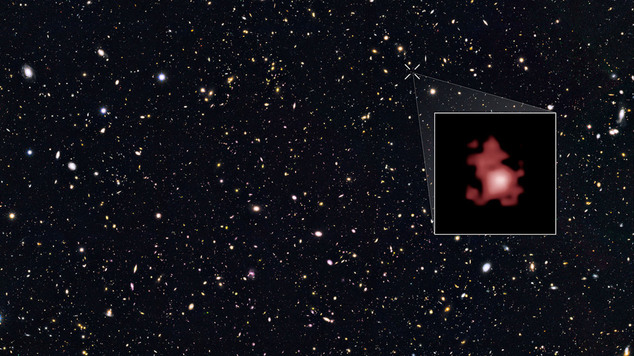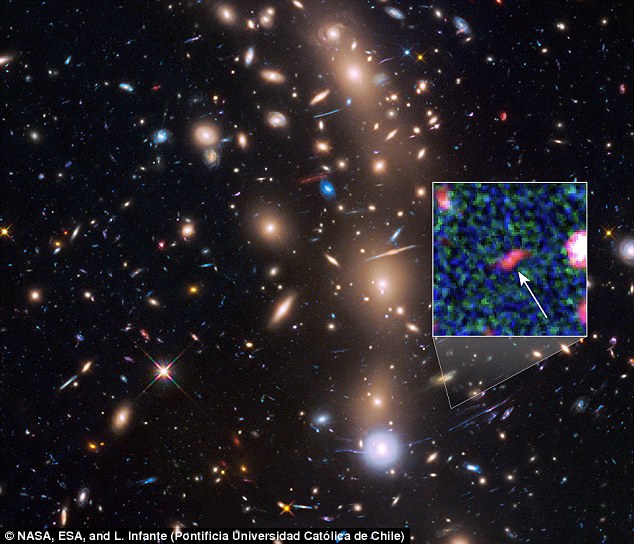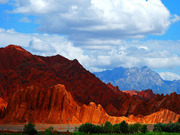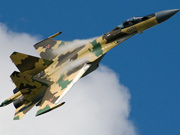

A galaxy far, far away has shattered the cosmic distance record set by astronomers.
Scientists pushed the Hubble Space Telescope to its limits to confirm that the galaxy is 13.4 billion light years away, the most distant and oldest object known in the universe.
The light we see from the galaxy began its long journey through space just 400 million years after the Big Bang gave birth to the universe.

The most distant and oldest object known in the universe: Galaxy GN-z11, shown in the inset, is seen as it was 13.4 billion years in the past, just 400 million years after the big bang, when the universe was only three percent of its current age.
Astronomers measured the distance to the galaxy, known as GN-z11, by splitting its light up into its component colours.
Because of the expansion of the universe, distant objects flying away from us have their light stretched to the red end of the spectrum - a phenomenon known as 'red shift'.
The larger an object's red shift, the further away it is.
Previously a galaxy called EGSY8p7 held the red shift record, a figure of 8.68. But GN-z11 has a red shift of 11.1, corresponding to just 400 million years after the universe began.
Dr Pascal Oesch, a member of the team from Yale University in the US, said: 'We've taken a major step back in time, beyond what we'd ever expected to be able to do with Hubble.
'We managed to look back in time to measure the distance to a galaxy when the universe was only 3% of its current age.'
The Big Bang is thought to have brought everything that now exists into being around 13.8 billion years ago.
GN-z11 is believed to be 25 times smaller than the Milky Way, but growing fast and spawning new stars 20 times faster than our galaxy.
The findings, reported in the Astrophysical Journal, raise many questions because according to current theories of cosmic evolution even a galaxy of this size should not have existed so long ago.
Co-author Dr Ivo Labbe, from the University of Leiden in the Netherlands, said: 'The discovery of GN-z11 showed us that our knowledge about the early universe is still very restricted.
'How GN-z11 was created remains somewhat of a mystery for now.
'Probably we are seeing the first generations of stars forming around black holes.'
Coauthor Garth Illingworth, professor of astronomy and astrophysics at UC Santa Cruz, said the team pushed NASA's Hubble Space Telescope to its limits to get the spectroscopic data needed to determine the galaxy's 'redshift,' a measure of its distance from Earth.
The new Hubble observations take astronomers into a realm that was once thought to be only reachable with NASA's upcoming James Webb Space Telescope.

The previous record holder: Astronomers harnessing the combined power of Nasa's Hubble and Spitzer space telescopes have found the faintest object ever seen in the early universe. Called Tyna, it existed about 400 million years after the big bang, 13.8 billion years ago.
'It's remarkable that Hubble could do this,' Illingworth said.
'This new discovery shows that the Webb telescope will surely find many such young galaxies reaching back to when the first galaxies were forming.'
'We've taken a major step back in time, beyond what we'd ever expected to be able to do with Hubble,' said first author Pascal Oesch of Yale University.
'It takes so long for light from GN-z11 to reach our telescopes that we see the galaxy as it was when the universe was only 3 percent of its current age, he said.
This measurement provides strong evidence that some unusual and unexpectedly bright galaxies found earlier in Hubble images are really at extraordinary distances.
Previously, the team had estimated GN-z11's distance by photometric techniques, using filters to measure light at different wavelengths with Hubble and NASA's Spitzer Space Telescope.
JAMES WEBB SPACE TELESCOPE: THE NEW HUBBLE
The James Webb Space Telescope (JWST) will be a large infrared telescope with a 6.5-meter (21ft) primary mirror.
The project is working to a 2018 launch date.
The JWST will be the premier observatory of the next decade, serving thousands of astronomers worldwide.
It will study every phase in the history of our universe, ranging from the first luminous glows after the Big Bang, to the formation of solar systems capable of supporting life on planets like Earth, to the evolution of our own solar system.

Nasa describes the telescope as a 'powerful time machine with infrared vision that will peer back over 13.5 billion years to see the first stars and galaxies forming out of the darkness of the early universe'.
Now, for the first time for a galaxy at such an extreme distance, the team used Hubble's Wide Field Camera 3 to precisely measure the distance to GN-z11 spectroscopically by splitting the light into its component colors.
Astronomers measure cosmic distances by determining the redshift of a galaxy.
Due to the expansion of the universe, every distant object appears to be receding from us because its light is stretched to longer, redder wavelengths as it travels through expanding space to reach our telescopes.
The greater the redshift, the farther the galaxy.
'Our spectroscopic observations reveal the galaxy to be even farther away than we had originally thought, right at the distance limit of what Hubble can observe,' said coauthor Gabriel Brammer of the Space Telescope Science Institute.
These findings provide a tantalizing preview of the observations that the James Webb Space Telescope will perform after it is launched into space in 2018.
The discovery also has important consequences for NASA's planned Wide-Field Infrared Survey Telescope (WFIRST), which will have the ability to find thousands of such bright, very distant galaxies.
Day|Week

 Qiandaohu supply ship named 'model ship' by PLA Navy
Qiandaohu supply ship named 'model ship' by PLA Navy Stunning Kuche on the Silk Road
Stunning Kuche on the Silk Road Tunisian man creates art of sand in Hangzhou
Tunisian man creates art of sand in Hangzhou Goddess teacher shares fitness program online
Goddess teacher shares fitness program online Getting close to PLA's easternmost post on the mainland
Getting close to PLA's easternmost post on the mainland 'Naked run' race held in Beijing
'Naked run' race held in Beijing Train Attendant Recruitment Held in East China
Train Attendant Recruitment Held in East China In pics: Russia's Su-35 fighter jets
In pics: Russia's Su-35 fighter jets Young monks learn kungfu in NE China temple
Young monks learn kungfu in NE China temple Scenery of Guzhu, thousand-year-old ancient village in E China
Scenery of Guzhu, thousand-year-old ancient village in E China